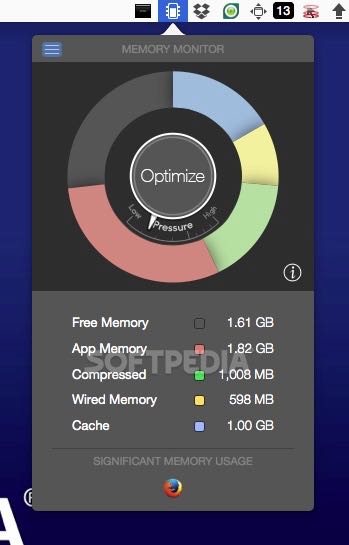
Consult the device manufacturer's documentation for more information on the problem and troubleshooting procedures. This data shows the calculated performance counter value that caused the health state change. Use the Health Explorer to check the details for the state change on the State Change Events tab for the monitor.
IOS MEMORY MONITOR FREE
This monitor enters an error state when the amount of free memory on the interface is less than the configured threshold. Number of consecutive samples before the monitor changes stateĪmount of time in milliseconds to wait for a response from the device before the sample times out and a new attempt is made to sample the value Number of attempts in each monitoring interval before the interval's sample is discarded The following options can be configured on this monitor:Īmount of time in seconds between checks of the device status Healthy: The percentage of free memory used is greater than the threshold.Įrror: The percentage of free memory used is below the threshold. You don't use it unless you are troubleshooting.The monitor indicates the level of free memory on this device. That means the process has crashed or is no longer functioning. Both systems also provide up to 4 gigabytes of addressable space per 32-bit process. Both OS X and iOS include a fully-integrated virtual memory system that you cannot turn off it is always on.

IOS MEMORY MONITOR CODE
4 GB of GPU memory for HD and some 4K media. In order to properly tune your code though, you need to understand something about how the underlying system manages memory. The only place in Activity Monitor where that means something different is when a process listed is in red. For a list of supported graphic cards, see Supported graphics cards for Adobe Premiere Pro.
IOS MEMORY MONITOR HOW TO
Nothing to do with something going wrong or gone wrong. First the title of your question is how to watch memory usage in iOS.There is a tool called instrument comes with xcode, which you can use to track memory allocation, leaks, cpu usage and a host of other things.See apple's documentation on the subject. Tap Options(three horizontal lines) at the upper left side of the screen. To check CPU usageon your iPhone, launch the app and go to the home screen. In Activity Monitor the red and blue graph lines are simply read/write or input/output. You can also see your iPhone’s internal activity and system data with a real-time memory allocation graph, memory clock, amount of memory, and much more. The article provides a comprehensive introduction to the basics of iOS. Before you start recording your own pit journey, I recommend an article: From OOM to iOS Memory Management Creator Training Camp. It will improve the performance of applications that run mostly in RAM or when loading programs. Recently, I am studying how to perform some simple memory monitoring in iOS applications, which mainly include memory leaks and memory usage. What it can do is prevent the system from having to use disk-based VM when it runs out of RAM because you are trying to run too many applications concurrently or using applications that are extremely RAM dependent. It doesn't speed up the computer nor make games run faster. If the figure in parentheses is running positive and your hard drive is constantly being used (thrashing) then you need more physical RAM.Īdding RAM only makes it possible to run more programs concurrently. If the value in the parentheses is 0 (zero) then OS X is not making instantaneous use of VM which means you have adequate physical RAM for the system with the applications you have loaded. If you open the Terminal and run the top command at the prompt you will find information reported on Pageins () and Pageouts (). If you are really in need of more RAM that would be indicated by how frequently the system uses VM. The Swap figure represents an estimate of the total amount of swap space required for VM if used, but does not necessarily indicate the actual size of the existing swap file. This will change as applications are opened and closed or change from active to inactive status.

The amount of available RAM for applications is the sum of Free RAM and Inactive RAM. Using Activity Monitor to read System Memory & determine how much RAM is used


 0 kommentar(er)
0 kommentar(er)
